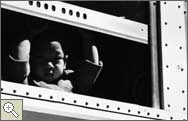
A month before Pearl Harbor, a State Department investigator named Curtis Munson submitted a report on the people of Japanese descent on the West Coast. He concluded that there was little evidence that they would be loyal to Japan in the event of war.
"They have made this their home," he wrote of the generation of Japanese immigrants called Issei, who could not become citizens because of an anti-Asian exclusion law. "They have brought up children here, their wealth accumulated by hard labor is here, and many would have become American citizens had they been allowed to do so." Those children, the generation of U.S.-born citizens called Nisei, showed an "eagerness to be Americans."
Despite the report, and against the judgment of members of his administration, President Roosevelt put the matter into the hands of the military by signing Executive Order 9066 on February 19, 1942. This authorized the Department of War to "exclude any or all persons" from areas deemed vulnerable to espionage or attack. The army's Western Defense Command designated the West Coast and the Arizona border as an exclusion zone, and soon began issuing evacuation orders to whole communities of Japanese Americans.
The evacuation of San Diego came in early April. Fifteen hundred people boarded trains without knowing their destination, and without ever hearing an official explanation for the action. They had packed for this strange new life as if for a brief trip—each person was allowed to bring only what he or she could carry. They arrived first at a temporary "assembly center" set up at the Santa Anita racetrack outside of Los Angeles. In August, they were moved to the Poston internment camp in western Arizona.
If American soldiers can endure hardships so can we!" sixteen-year-old Louise Ogawa wrote to Miss Breed from Santa Anita. From Poston, she wrote, "When I stop to think how the pilgrims started their life, similar to ours, it makes me feel grand for it gives me the feeling of being a pure full-blooded American."
This was not the official view. Stated a colonel in the Western Command, "I am determined that if they have one drop of Japanese blood in them, they must go to camp."
|
 |
 |
 |

I shall never forget how I spent that night of April 7th sleeping on the train. My sister and I stuck our heads out the window never peeling our eyes off the direction of our home. We filled our eyes with the sight of San Diego to the limit until my pupils gave in and I dozed off.
--LOUISE OGAWA
|
 |
 |
 |
 |
 |
 |

Girl in Train Window for Evacuation by Dorothea Lange (1942).
|
 |
 |
 |
|

